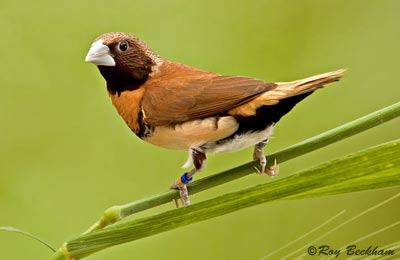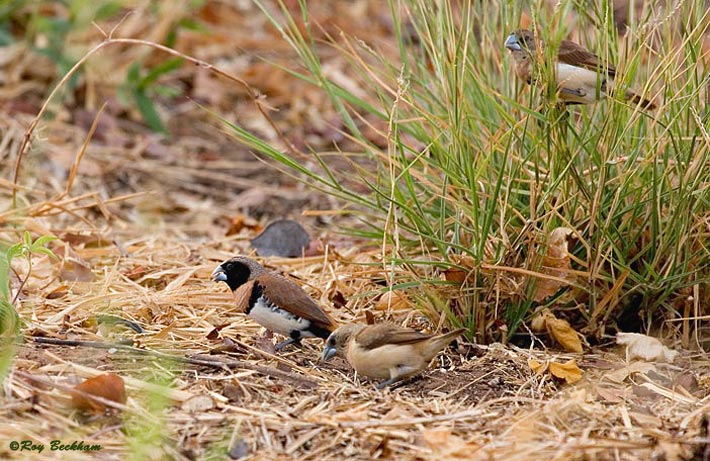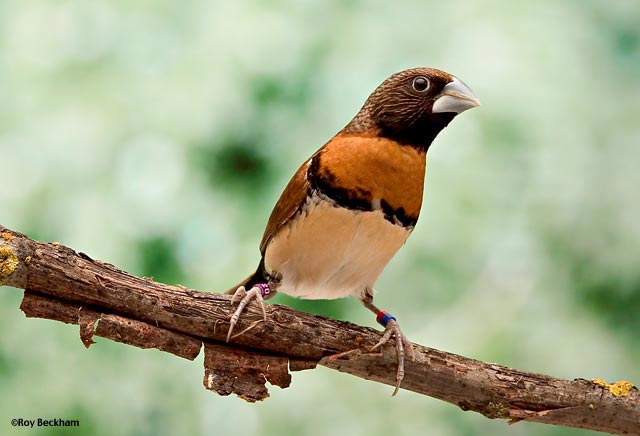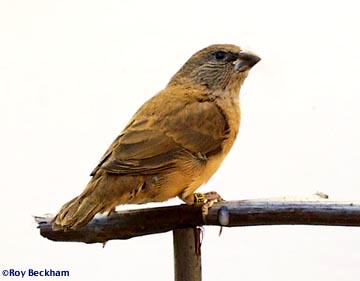|
Common Names
Chestnut finch, Barley Bird (Australia)
Description
Males and females are nearly identical in appearance. Like most members of the Lonchura family there are subtle clues to help determine sex. Males will of course sing and do a courtship dance. This song is actually quite melodious and the males will sing quite often making them easy to spot. (MP3 of the male's song) Other Chestnut Breasted will peer next to a singing male as though hanging on every note he sings. Peering is not necessarily a sign of a hen however, as other males will peer as well, but singing and peering usually precedes any mating. The physical signs to look for in a male are better seen in a group rather than just two individuals. They include a broader, bolder head and beak, blacker face with less flecking and brighter chestnut color on the breast. It is also said that the tail is a brighter yellow on the males. I tend to rely on the singing of males and look for the brown flecking in the face of the birds that do not sing to find hens.
Diet
Like most mannikins or munias, Chestnut Breasted mannikins prefer the larger millets in a standard parakeet mix or just White Prosso seed. They will also eagerly eat my eggfood (Roy's eggfood), greens and soaked seeds, especially Paddy Rice. They also really like Oat Groats, but watch their intake of this since it can result in fat birds. Grit and calcium in the form of crushed egg shell and oyster shell as well as cuttlebone should always be available to them.
Breeder's Notes
The Chestnut Breasted mannikin can be bred in cages or aviaries. One breeder I know breeds them in a colony in a large planted aviary. This apparently has worked very well for him as he has bred quite a number of them in his first year. I am now trying mini colonies of 3 pairs per flight cage. It seems that only the dominate pair will be successful in such situations though. CBMs apparently form fairly strong pair bonds and if you split a pair up and they are still within hearing range, you'll hear them calling for each other for the first few days. Afterwards, they may not call to each other as they did before, but they also don't seem to want to settle down with the supplied mate and nest. The colony system allows them to select their own mate, guard territory and in general, act more naturally since these birds form colonies in the wild. I have bred them successfully in single pairs in my smaller breeding cages though. Watch for feather plucking though. They can start to pluck tails and feathers at the nape in colonies.
I offer my CBMs a standard half open finch nest box. Others have reported a success with the baskets, but I'm not fond of using these with mannikins that have a tendency to grow long nails. With the half open boxes, I will often prop open the top or remove the top entirely (see below). In this they will often construct an elaborate nest complete with dome top. I provide them with coconut fibers, rice hay, jute, cotton fibers and feathers. My nesting pairs used the rice hay for the outer layers and wove in the coconut fibers for a lining and interior shape.
The clutch of 4-8 eggs will quickly follow nest construction. The female takes on the majority of the sitting duties while the male stands guard. Both birds will sit in the nest at night. Incubation lasts for 13-14 days and the typical Lonchura chicks hatch out naked and pink. The young fledge in 18-21 days and are a buff brown color overall. They are weaned in about 21 days.
I have read that some people have difficulties when fostering Chestnut Breasted Mannikins with Society finches. I think that mixing CBMs with the Society's young or the young of other finches may be part of the problem. While I don't think that Societies are particularly sensitive to the mouth markings of the Chestnuts, they do seem to favor their own young. This could be due to the young CBMs begging noises or head movements or something else entirely, but they are able to differentiate their young. If fostering CBMs, it may be your best bet to exclude other species in the clutch. I have recently had a pair of CBMs foster a clutch of Societies, so it can work in the reverse as well.

Wild Chestnut Breasted Mannikins feeding. Kununura, Western Australia.
Additional Notes
There are five subspecies of Chestnut Breasted mannikins. One in Australia and the rest scattered through New Guinea. The most dramatic and attractive of the subspecies is the race L. c sharpii. These are still occasionally imported, but being wild caught they are not as eager to breed as the domestically raised nominate Australian birds. All the Australian races are from domestic sources since Australia has banned all exports.
There appears to be a melanistic phase of the Chestnut Breasted mannikin. It is not a mutation or morph and the cause is unknown (Picture from Australia)
Like many of the Asian Lonchura family, the Chestnut Breast suffers from long toenails. This is probably great in the wild if you're hanging vertically from a reed, but can be dangerous in a cage. Keep a close eye on this and trim when necessary.
Feather plucking is rarely a problem in mannikins, especially the Asian mannikins, but the CBM can get aggressive and pluck tails and the backs of necks. Crowding seems to trigger this.
|












